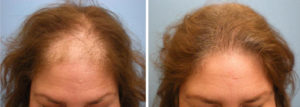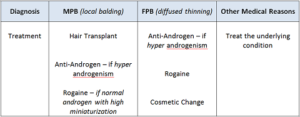5 STEP MANAGEMENT OF HAIR LOSS IN WOMEN
Even though hair loss is viewed as a problem that mostly occurs in the lives of men, women are almost as likely to suffer from thinning hair. It’s an issue for women of any age and can happen for a variety of reasons. While men’s hair usually recedes from their forehead or the crown of their head, women usually have more diffuse thinning (spread out over a large area) on both the front and top of the scalp.
Hair loss can be a big blow to the image and self-esteem of women. While not every case of female hair loss is a perfect fit for a hair transplant, some types of female hair loss can benefit from a hair transplant.
Here are five steps that most female patients can take to manage their current hair loss as well as prevent further loss.
STEP 1: HISTORY
The first and maybe most important step in managing female hair loss is building an accurate patient history. This history should include a listing of family hair loss as well as a list of the patient’s medical problems and medications.

If there is not a strong family history of female hair loss then it’s time to start looking for other hair loss causes.A lack of family history may indicate that the person is not suffering from a typical case of female patterned hair loss.
There are some medications that have hair loss as one of their known side effects. A complete medical history is vital in the evaluation and diagnosis of the cause of the hair loss experienced by the patient.
STEP 2: MACRO AND MICRO-EVALUATION
A thorough examination of the patient’s scalp should be performed to determine if there are any abnormal patterns present. Microscopic evaluation of the scalp, as well as the hair, is a big component of evaluating hair loss in a female patient.
Hair shafts become fine before they are lost. If the patient has fineness of more than 20% of her hair shafts, that amount can’t be explained away by the natural recycling of normal hair. The mapping of scalp hair miniaturization is a helpful guide to evaluate the treatment success rate. It also helps to predict the future pattern of hair loss.
STEP 3: LAB WORK
Lab work is not a given in each case but it might be necessary for some women with hair loss. The lab work can range from a CBC (Complete Blood Count) to an Iron Panel and hormonal levels. The Iron Panel may include serum iron levels, TIBC (Total Iron Binding Capacity) and ferritin levels (measure the amount of iron stored in the body).
Hormonal levels will need to be checked as well in the patient. Why? Hormonal imbalances can be a reason for hair loss and thinning in women. The most common levels checked include:
*Total and Free Testosterone
*DEHA-Sulfate
*Prolactin
*T3, T4 and TSH
After these tests are complete there might be a need for a few other specific tests. Also, the doctor may have to obtain a scalp biopsy in order to eliminate the possibility of other skin conditions leading to the hair loss. Examples of these conditions include Alopecia Areata and Alopecia Cicatricial. We evaluate that need on an individual patient basis.
STEP 4: DIAGNOSIS
The decision of what treatment to undertake for the patient’s hair loss is decided on after a diagnosis from the doctor. If there is a medical condition causing the loss, it must be treated before any treatment. If we don’t discover another medical condition causing hair loss, the most likely diagnosis is male or female patterned baldness. We may offer a variety of treatment for each condition.
STEP 5: TREATMENT
One of the common types of hair loss in women is diffuse hair loss. Patients experience a high level of thin hair and we detect high rates of miniaturization of hair in our microscopic examination. Patients who have a high level of miniaturization are generally not good candidates for a hair transplant. These patients mostly require medical treatment with minoxidil (Rogaine) and low level laser therapy (LLLT).
Which patients make good candidates for hair transplantation? Women with local hair loss as well as asymmetrical loss of hair in the front with the donor hair on the permanent zone being preserved.
One important aspect of hair loss treatment is making sure expectations are set at an attainable level. Not all patients can expect to see the same outcome and should enter treatment with a realistic goal in mind. Also, more than one transplant may be required for best results in some women and the patient should be aware of this fact in advance.
Table 1: Association of each diagnosis of female patterned hair loss with its treatment options

A specialist in the field of female hair loss should have a good working knowledge of cosmetics which are useful in enhancing the appearance of women suffering from male or female patterned hair loss. The specialist should be knowledgeable about various shampoos, conditioners and other hair products and their effects (good and bad) on hair appearance.
Learning how to properly style your hair to avoid further damage, hair coloring tips and other cosmetic changes to a daily hair style routine can be a big help in the hair loss consultation process.
CONCLUSION
The approach taken to treating women who suffer from hair loss is different than the treatment of men who suffer from typical male patterned baldness. A thorough evaluation and correct diagnosis can make all the difference in the treatment success. Deciding on medical treatments to maintain the current hair might be a better option than a hair transplant in some cases. Whichever option is chosen, it’s vital to make sure all parties enter the treatment with the same expectations.
The challenges of dealing with, and correcting, extensive hair loss can lead to a life changing experience for patients. A well planned combination of medical treatments, hair transplantation and cosmetic choices can work wonders in creating the appearance of full, healthy and vibrant hair in those women who suffer from hair loss.